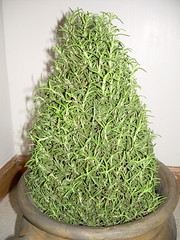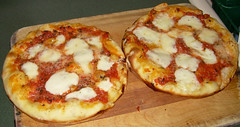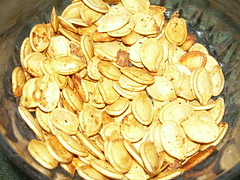 It's been a rough year. Family tragedy followed by moving to a new house (not a home yet). The move's good, but stressful. The family tragedy? Well, things will hopefully get better over time. Don't know.
It's been a rough year. Family tragedy followed by moving to a new house (not a home yet). The move's good, but stressful. The family tragedy? Well, things will hopefully get better over time. Don't know.
Just wanted to log this recipe for an unbelievable looking mixture of spiced nuts that, if they turn out well, will be gifts next year. And, I hope they're good because no one, with the exception of Frankie and Trish, got a thing this year. Sorry all.
Here's to 2007 being a better year.
12.21.2006
Giada's Nuts
11.27.2006
Coffee Roasting (expt 1)

I started roasting coffee recently. Click here for the larger size; very cool shot. Unfortunately, looks better than it tasted. I chose a Sumatra decaf green bean from Yeah, me too on Indianola (Columbus, OH) for starters. For roasting equipment I used an unmodified Hamilton Beach Poppery II (scored for $2.99 from Ebay) and roasted 1/2 cup of green beans for 10 minutes.
I conducted this outside at about 50 deg-F for a timed 10 minutes. Despite the satisfying color of the roasted beans, I think I under roasted them. After roasting them, I cooled them in a cast iron pan (to dissipate the residual heat; halting the roasting by removing residual heat is supposed to be effective) and waited a couple hours before grinding them for a cup of brew in my drip machine.
The final coffee had nice color, reasonable taste, but was a tad winey-tasting. I suspect they were a tad underdone. I also spoke to some friends about my results and they agreed the ambient outdoor temperature* was too low to get a good rich roast outside in only 10 minutes.
I'll be trying this again soon. It's fun, Frankie likes to watch and the final results are never wasted. I think I just need a more reliable endpoint to shoot for. The first crack was faint and barely detected and I don't even know if I made it to the second crack.
Results will be disclosed as experiments continue.
*I did this outside because of warnings from friends about big plumes of smoke when the beans start to achieve a dark roast. I never noticed this. Again, possibly indicative of too cold an environment to get the full roast.
Update 08-Jan-07
I repeated the roasting indoors (ambient temp ca. 64-deg-F for a full 12 minutes. I was hearing the second crack when I stopped the roasting (first crack around 5-6 minutes). Dumped the batch (1/2 C) into cast iron and it was all shiny and dark. Here's the final product. Tasted as good as it looked.
11.11.2006
Come hither our victim
And subject it to a slow, mold-induced death.
Ideally, we'd like it to thrive indoors until spring and maybe even have some to harvest for our focaccias and roasted roots. But, we don't have good luck with these things. They generally look ok for a couple weeks. Inevitably, mold sets in and it's just a matter of time from that point.
So, if anyone has luck wintering these things, shoot me some advice via the comments. I'll keep you posted on its "progress". Currently, it's a week old and it has a surprising amount of new growth. I'm afraid to water it.
update
Time of death, early december.
11.07.2006
Pizzas: Kneadless Expts.
This night, I decided to take the same dough, divide it into two 250 g lumps and make pizzas out of it using 9" cake pans. My usual pizza prep involves fairly extensive kneading of the dough. But, I'm a wicked busy parent and looking for any possible way to get good food to the table in a shorter amount of time. I thought this expt. would be pretty fun too.
I made the dough as in the previous focaccia, post, divided it, plopped each lump into a 9" cake pan (dark, non stick), topped them with pureed tomatoes, oregano, good mozzarella, salt, pepper and tossed them in a 450-deg-F oven (middle) for 15 minutes.
Results
Crust was, like the focaccia, soft, not too chewy, cooked well all the way through (kind of a thick crust), and tasty but far, far from the robust crust of a well-kneaded dough.
My next foray into this kneadless stuff will be tonight when I apply the method to our night's baguette; a very lean dough (it's bread, cheese and salad night in our household). I'll post results.
Now vote, damnit.
11.02.2006
Roasting soon
The web will never cease to amaze me in it's breadth, but in every niche, there's a surprisingly limited vocabulary that's used. Almost everyone who does this sort of thing knows Sweet Maria's and also knows the Hamilton Beach Poppery II is one of the best hot air poppers to use as a primitive roaster and it does a darn good job. And, there's about a million people who've modified these things to fine tune the roasting process ... another post.
I also got a tip that in some way, the proprietor of the Columbus coffee shop Yeah, me too (on Indianola) is in someway related to Sweet Maria's and their beans pass muster with the best of them.
All I need now is a burr grinder and I'm ready for coffee heaven.
10.30.2006
Punk'in seeds
Anchos are nice and spicy but not hot. Perfect for good flavor but don't scare away Frankie. I use it making chilli, spicing up beans, etc. I usually buy the dried smoked chilis and cut out the white parts, remove the seeds and pulverize them in a spice blender. They keep forever. Once in a while, the particular lot I buy is still kind of moist and I'll have to dry them in the oven at about 170-deg-F for a couple hours.
So, last night, while the wife and kid were working on the jack 'o lantern, I grabbed the seeds and went to work. Cleaned them up, sprinkled them with ancho chili powder, salt, pepper and gave 'em a quick squirt of olive oil and baked them at 250-deg-F until crisp. Yum.
10.23.2006
Focaccia, kneadless
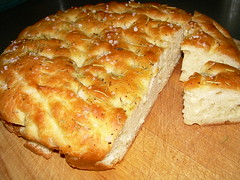 Sunday evening meal. Like to make it a special one. Sunday nights should be special. Everyone gearing up for the week. We were having italian sausages simmered for several hours in tomato sauce over pasta and we wanted some fresh bread (or as Frankie calls it: "Papa's good bread") to go with the meal, but after a long day of parenting, I was bushed.
Sunday evening meal. Like to make it a special one. Sunday nights should be special. Everyone gearing up for the week. We were having italian sausages simmered for several hours in tomato sauce over pasta and we wanted some fresh bread (or as Frankie calls it: "Papa's good bread") to go with the meal, but after a long day of parenting, I was bushed.
I read a book a while back called No Need to Knead. Her basic premise is you get more rustic looking breads (big irregular holes and such) with less kneading. I don't think the premise is valid but it sure sounded appealing when I wanted a fresh loaf. So I weighed out water (200 g, warm tap), a T or so of honey, 1-2 t of dry yeast, olive oil (2 T) and swirled the mixture in my plastic bowl I use for raising dough. Then, I tossed in unbleached white flour (300 g) and salt (5 grams) and mixed the mixture with a metal spoon until it came together, and mixed another couple turns and closed it up (this container I use has a 2 mm diameter hole in the top for venting the gas) and went to wrestle Frankie.
Within an hour and a half, it had risen nicely. I sprinkled on some flour and squashed it down. It wasn't as sticky as I thought it would be. I let it rise a second time only about a half hour. Then I plopped the mass into a 10 inch dark, non-stick cake pan (oiled lightly) and preheated my oven to 450-deg-F.
I pushed the blob out to fill the pan, Frankie painted the surface with oil, I sprinkled rosemary and coarse sea salt on it and let it sit uncovered for 15 minutes. Then, I docked it and pushed it in the oven for 15 minutes. Wow. What a focaccia for very little work!
However, it was very soft. Very flavorful but very soft and chewy. A great bread but don't know if I'd like it as a staple in our repertoire of breads. Definitely fit the bill for an exhausted parent.
food foccacia baking kneading bread
10.09.2006
Chicken 'n Noodles (wicked fast)
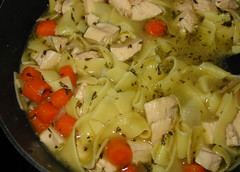 A neighbor of ours makes the absolute best chicken and noodles we have ever had the luxury of tasting. She makes her own noodles and even invited me to witness this stupendous dish being prepared. There's really no big secret. She made a tender noodle using flour, some oil, water, salt and hand rolled them. No biggie. The chicken soup was also nothing secretive. A good stock derived from a bone-in chicken, veggies, etc. I kept looking for the secret ingredient. She told me it was the Knorr's cube she used. No matter how hard I looked, I couldn't find anything unconventional that made her soup so special. I left after the tutorial. A few days later, we were talking about the soup again and she mentioned "oh yeah, and a stick of butter" (was added towards the end of cooking). Bingo.
A neighbor of ours makes the absolute best chicken and noodles we have ever had the luxury of tasting. She makes her own noodles and even invited me to witness this stupendous dish being prepared. There's really no big secret. She made a tender noodle using flour, some oil, water, salt and hand rolled them. No biggie. The chicken soup was also nothing secretive. A good stock derived from a bone-in chicken, veggies, etc. I kept looking for the secret ingredient. She told me it was the Knorr's cube she used. No matter how hard I looked, I couldn't find anything unconventional that made her soup so special. I left after the tutorial. A few days later, we were talking about the soup again and she mentioned "oh yeah, and a stick of butter" (was added towards the end of cooking). Bingo.
She essentially "mounts" the soup with butter. I don't think this is mounting as it's usually used, but the end result is still decadent richness.
The other day while driving Frankie to school, she requested chicken 'n noodles for dinner. I thought, great, a weeknight and all I have is some frozen boneless chicken in the freezer and some dry noodles in the cupboard. Butter to the rescue and voila! A wonderful fast chicken and noodles in a flash was born. We use it pretty often now and is it yummy.
Quick Chicken and Noodles
onion, 1, chopped,
garlic, a few slivers
olive oil, about 1-2 T
carrots, a bunch, chopped
1-2 chicken breasts, frozen, boneless
water, ca. 2-2.5 quarts
parsley, dried, 1T
salt, 2t
pepper, to taste
oregano, dried, 2t
egg noodles, most brands are good, 1/2 lb, dried
butter, 3T
Saute onions, garlic, carrots a few minutes, toss in hunks of frozen chicken and water, parsley, salt, pepper and oregano; bring to a boil and simmer for about 30 minutes. Remove chicken and chop, return to pot. Drop in noodles and continue simmering 10-15 minutes. Finally, stir in butter and serve. The butter takes care of all your shortcuts (boneless breasts, no stock, etc.) and since we don't throw in gobs of it, it's not even that unhealthy since it yields at least 4 healthy servings. Enjoy.
food chicken+noodles soup comfort food
10.05.2006
Desperation Dinner #2 (in a long drawn out series)
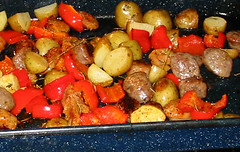 Over the years I've noticed the color of cookware can have a profound impact on the food. When baking, dark cookware darkens food more while bright aluminum sheets make it tough to darken the bottoms of cookies. Makes sense; absorbs more heat and transfers it to your food. I guess that's why my orange terra cotta tiles in the oven are so perfect for pizza. Browns the bottom at just the right rate so the top can brown at about the same rate.
Over the years I've noticed the color of cookware can have a profound impact on the food. When baking, dark cookware darkens food more while bright aluminum sheets make it tough to darken the bottoms of cookies. Makes sense; absorbs more heat and transfers it to your food. I guess that's why my orange terra cotta tiles in the oven are so perfect for pizza. Browns the bottom at just the right rate so the top can brown at about the same rate.
When it comes to baking in a pan though, I prefer darker cookware. Cast iron is a favorite of mine but sometimes I just prefer something lighter. My second favorite bakeware is enamel on steel. The speckled stuff. Sturdy, cheap, perfect for roasting roots.
This meal, inspired by my Mom (who does this in clear glass most of the time, my least favorite bakeware) is the best. Everything gets a nice crust to it and cooks evenly. AND, it takes about 30 seconds to prep and about 40 minutes to bake (while I play with the kid). With that ramble in context: I chop frozen italian sausages, peppers and potatoes into about the same size cube (bit size), toss them into my enamel on steel pan, drizzle olive oil over it all, salt, pepper and rosemary, shake to distribute the oil and spices and bake at 400-deg-F for about 35-40 minutes. You can use any vegetable medley you please and it's a simple complete meal (as long as you're not a vegetarian).
food desperation dinner sausage cookware
9.13.2006
The Bomb
A couple weeks ago, I visited my parents and got my fill of the cleavage and nice hair channel FoodTV. Not in my own kitchen at the time, I could only jot down some notes on what I committed to do. Someday that is - after we move.
Not since Molly's waffles (Molly, I'm going to make these someday if it kills me!) have I seen a recipe so decadent. It's from a new guy who calls everything "the bomb". Some hipster term I don't have time to look up. I think it means something good.
He made pork carnitas and the thing that caught my eye was the way he prepared the pork. It was "the bomb". He took a boston butt, ca. 4-5 lbs, and cut it in four chunks. Then he deep fried it in Manteca (ca. 2-3 quarts; a kind of lard, pork-derived I think) heated to approximately 300-deg-F (I'm sure the temp went way below that with all that mass) in a cast iron skillet for about an HOUR. He took it out, let it rest and it pulled beautifully. I was salivating excessively. Before I die, I will cook a pork butt like this. Anyone ever tried this method?
food boston butt carnitas foodtv
7.27.2006
Hoummus b'Tahini
Hummus or however you spell it, is a staple in our house. It's popular with us because it tastes good, it's healthy and contains only a handful of ingredients.
It's also one of those mixtures that everyone seems to make with their own "special twist". This special twist scares me. Hummus, as far as I'm concerned, shouldn't have funny things in it (roasted red peppers, chilli powder, bludgeoned with garlic, etc.) and the amount of lemon juice is pretty critical too.
From '94 to '98 I did some federal time at the FDA. While there, an Egyptian friend of mine gave me Lebanese Cooking that has, what I consider to be, the authoritative source for the only hummus recipe we use. The recipe hydrates and cooks chickpeas from scratch - I don't. Aside from that, here's our version of this middle eastern classic. We serve it with a plate of fresh veggies, pita, pickles and a salad.
Don't worry Biggles, I'll be posting some meaty kibbeh recipes soon too.
Hummus
chickpeas, 2 cans, 14.5 oz with liquid
tahini, well-mixed, 120 grams (1/2 cup)
lemon juice (of 1 lemon, ca. 1/4 cup)
salt, 1/2 t
olive oil, 30 grams
garlic, 2-4 slivers
Process all ingredients until smooth adding additional water if necessary to achieve your desired consistency. I like it smooth and with the water from the canned chickpeas, it gets nice and smooth. Serve slightly chilled with a drizzle of olive oil and parsely (optional garnish).
7.16.2006
Rosemary-Infused, Sweetened, Roasted Pecans
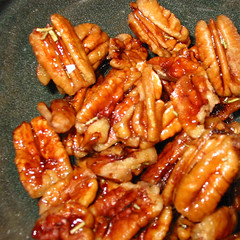 I think the best part of a restaurant salad are those cool sweetened pecans they top it with (although, the crumbled goat cheese is good too). The only problem with these is they're often a bit too sweet, candied. So, I made my own.
I think the best part of a restaurant salad are those cool sweetened pecans they top it with (although, the crumbled goat cheese is good too). The only problem with these is they're often a bit too sweet, candied. So, I made my own.
The other night, we were still detoxing from too many burgers eaten at a cookout. We had salads with some lentils on the side. Very satisfying. But, at the last minute, I had the urge for some slightly sweetened roasted pecans on the salad. This is how I made mine. Took about 5 minutes on the stovetop with a non stick pan. They were wonderful. Frankie loved them too.
Rosemary-Infused, Sweetened, Roasted Pecans
A handful of pecans (ca. 1/2 cup) were tossed into a non-stick fry pan on medium high heat with about a tablespoon of olive oil and a teaspoon of rosemary sprinkled over it all. Then, I sprinkled about a tablespoon of sugar over the mixture, continued heating and then poured about 3 tablespoons of water over the whole hot mixture. The water dissolved the sugar and suspended the rosemary. For the next few minutes I swirled the nuts in the hot solution letting the water evaporate. After the water was gone, I continued to heat the nuts for about 2-3 minutes and finally dumped them from the pan onto a wooden cutting board. When the sticky hot nuts cooled they were mildly candied and crisp. The rosemary was a fabulous touch. A friend of ours makes something similar but I forget her process. Thanks for the inspiration Amy!
7.04.2006
The Cooling Effects of R-134a on a Ternary Mixture of Cream, Milk, and Semisweet Chocolate
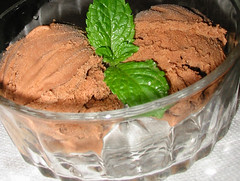 ... or the making of some killer ice cream.
... or the making of some killer ice cream.
I got this ice-cream machine a year ago from my dear family for Father's Day and haven't had a chance to use it until now (3-year olds require a bit of attention you know). Anywho, Trish initiated the effort by making a mixture of cream, milk, chocoalte chips, vanilla, some sugar and chilled it in the fridge for a few hours. It was then churned for 25 mintues in the ice cream machine.
Most sub-$100 model ice cream machines use a prechilled bowl to effect the gradual chilling of the ice cream mixture. The refrigerant sealed in the bowl most commonly used in these machines is R-134a (1,1,1,2-tetrafluoroethane). We prechilled the container (for about a year) in the freezer and let it churn our ice cream to be for 25 minutes. We then poured the grainy mixture into a plastic container (initally dissapointed because the texture seemed off) and placed it in the freezer.
Apparently lots happened in the next few hours. It was like very cold chocolate mousse. Yum. But, not quite like ice cream. The next day, however, upon continued storage in the freezer, it became very firm, very smooth and very much like some of the best "toklit" (Frankie's pronunciation) ice cream we'd ever had - and from such a simple mixture. Definitely worth the minimal effort. Thanks family. A device we'll use too much in years to come.
7.02.2006
Mmmm ... steak.
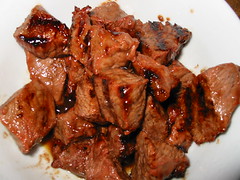 I don't remember what cut I bought last night but it was about $9/lb and I cut it into cubes to marinate in a light barbecue sauce. I've been doing thin steaks lately and I've become darn good at them on my Q. The trick to a steak is knowing how much time it should be grilled rather than going by internal temperature (IT). The IT is probably the best way to get to perfect steak finishing point but, it takes too long to take the temperature, especially on small tips like these. By the a stable reading is achieved, it could be way overcooked.
I don't remember what cut I bought last night but it was about $9/lb and I cut it into cubes to marinate in a light barbecue sauce. I've been doing thin steaks lately and I've become darn good at them on my Q. The trick to a steak is knowing how much time it should be grilled rather than going by internal temperature (IT). The IT is probably the best way to get to perfect steak finishing point but, it takes too long to take the temperature, especially on small tips like these. By the a stable reading is achieved, it could be way overcooked.
So, for most steaks about an inch or so thickness, I pre-heat thoroughly (there's a cast iron grill on the "Q") and go 3 minutes a side and finally end it by covering the meat with foil for a good 5 minutes. For the steak tips shown here, although I marinated in barbecue sauce, most of it was lost in the cooking and the meat had a perfect amount left on it. Served with rice and steamed cauliflower and broccoli, it was a perfect meal.
6.15.2006
We never waste greens
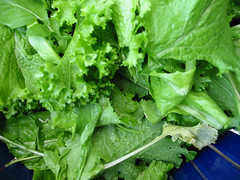 Common problem: you plant a bunch of greens and suddenly you can't keep up with the green leafies. The just take over.
Common problem: you plant a bunch of greens and suddenly you can't keep up with the green leafies. The just take over.
Our mix this year had a high mustard green content and the resulting salads tended to be hot. Like, horseradish hot. Wicked hot. So, the other day, having a simple meal of ham 'n beans we needed something green. I mowed these babies down, washed them and simply sauteed them using a bit of olive oil and tossed in the leaves still moist from washing. I usually have a couple garlic slivers in the oil but forgot this time and just seasoned them with a bit of salt. I sauteed the vibrant greens for about 10 minutes and were they good. And, a huge batch of fresh greens condense in the pan to a small lump when cooked. Very tasty way to take care of the overgrown garden.
6.12.2006
Shrooms 'n Tofu
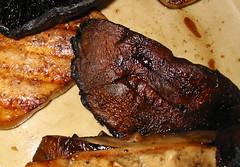 Mushrooms and tofu?
Mushrooms and tofu?
Saturday night the family and I made the mistake of being lured into a meal full of fried "seafood". One of those things you do when you're starving but regret immediately after the feeding frenzy is over. The memory of this meal needed to go away. We probably needed to fast a couple days but instead, decided to eat something reasonably healthy. Once I made it through the night, my apetite eventually came back and I got an urge for grilled mushrooms and tofu of all things (while chasing Frankie around the Zoo).
This meal turned out better than I expected and was trivial to prepare. I used extra firm tofu (1 lb.) sliced in 1/4" thick rectangles and cut the Portobello caps in half (6 of them). All the pieces were placed in a big bowl and to this added about 3T sesame oil, 2T soy sauce and about 2T rice wine vinegar and let it all marinate about 3 hours at room temp. The bowl was swirled several times to get the marinade mixed and redistributed several times during the 3 hours. Everything was grilled on my faithful Weber Q for 20 minutes onlow heat and everything was flipped once. The tofu held up well during the grilling. I served this with some basmati cooked in chicken broth. I think the only thing I would've changed is using a bit more soy and adding scallions to the marinade.
5.28.2006
Don't cover that dough!
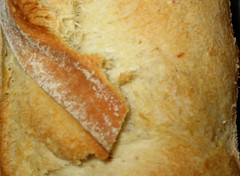 Couple interesting observations lately that busy parents may find interesting. The other night, I was making pizza. Toppings that night were seasoned pork, caramelized onions, mozzarella and some San Marzano tomatoes (canned). Very nice. Today, I'm making a couple baguettes. When I'm proofing the dough for these two household staples (the final rise prior to entering the oven), I'm usually cautious to dust the dough with flour (to prevent sticking) and cover them with an inverted bowl or a piece of plastic weighed down with a dishtowel to prevent the dough from drying out. In both of these cases, the dough was made the day before and placed in the fridge for the first rise. Don't know if this is a critical factor or not.*
Couple interesting observations lately that busy parents may find interesting. The other night, I was making pizza. Toppings that night were seasoned pork, caramelized onions, mozzarella and some San Marzano tomatoes (canned). Very nice. Today, I'm making a couple baguettes. When I'm proofing the dough for these two household staples (the final rise prior to entering the oven), I'm usually cautious to dust the dough with flour (to prevent sticking) and cover them with an inverted bowl or a piece of plastic weighed down with a dishtowel to prevent the dough from drying out. In both of these cases, the dough was made the day before and placed in the fridge for the first rise. Don't know if this is a critical factor or not.*
During the final proof of the pizza, I was too busy getting the dog to pee and preventing Frankie from doing something that I didn't cover the thin slab of dough for up to 45 minutes! It was lightly dusted with flour and it didn't dry out - at all. I topped it, baked it and voila! Pizza as usual with no fuss covering it during the final proof. Same with the baguettes. Shapped the loaves, placed them in the baguette pan and let them proof for 20 minutes (since the dough had just come out of the fridge and only briefly warmed up, this proof could've been a bit longer) and then popped them in the oven. Great oven spring and great loaves. Pretty handy to know. It's not that it saves a ton of time, but covering these lumps 'o dough, involves a bit of extra care and cleaning that I no longer will do.
*One possible hypothesis is the slightly cool dough has a net flux of moisture outward (from dough to environment) as it warms to room temperature, thus preventing the dough from drying out, or maybe this temperature difference causes condensation also preventing drying out the surface.?
5.25.2006
Tilapia, simple and good
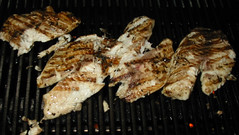 Are those cobwebs on my grill?
Are those cobwebs on my grill?
Where have I been? Do you know how active a 3-year old can be? Just one too. So all you parents of more than one won't be sympathetic, but with two of us working full time, the daycare scramble, chasing down the kid (who does NOT like to wear clothes), and trying to help her appreciate food as much as we do leaves much less time for blogging about food than I'd like. In the past few months I have managed to smoke one darn good picnic roast on the 'ol Weber kettle; that's it for low 'n slow cooking.
But, for the day-to-day, I've gone to the dark side I'm afraid. No, I'm not a vegan but I've bought into propane and propane accesories. I now frequently use my Weber Q. I'm afraid it's the new love of my life. It's been a mighty player in the protein, starch, veggie dinner we so demand. And ... it's darn fast. Ten minute warm-up, cast iron grid and hot as the sun to sear the delicate flesh of most living creatures.
Last night, we chose Tilapia for the protein source of the meal. Started with frozen fillets (hey, we're stuck in the ample lap of the heartland here), thawed for a day in a simple marinade of olive oil, salt, pepper and a few finely chopped herbs. Ten minutes before dinner while the rosemary roasted potatoes were still in the oven and broccoli and cauliflower steamed on the stove, those fillets hit the blazing hot grill with a huge whoosh of flames. Frankie watched and told me to watch out!
The key to good fish on the grill, I've learned, is to rely on a preset time (most fillets take only 3 minutes or less per side). Spending time taking their temperature to see if they're done will ultimately result in fish jerky (which my family has suffered through in the past, bless their hearts). Last night's tilapia was sublime. Tender, flaky and Frankie ate a ton!
1.17.2006
Challah
 I was trying to incorporate Frankie into an activity during one of our "stay home days" (the weekend). I thought a Challah would be a nice way to incorporate the fun of rolling out play-doh, braiding and painting. She seemed to have fun and actually helped quite a bit.
I was trying to incorporate Frankie into an activity during one of our "stay home days" (the weekend). I thought a Challah would be a nice way to incorporate the fun of rolling out play-doh, braiding and painting. She seemed to have fun and actually helped quite a bit.
I love this loaf, and it's good when it gets stale (if it lasts that long) for French toast (one of Frankie's favorites).
Frankie's Challah
Milk, 300 g
honey, 30 g
butter, 36 g
2 egg yolks
unbleached white flour, 500 g
salt, 10 g
yeast, 1 pkg rapid rise
+ egg yolk and milk (ca. 1:1 v/v)
a preheated oven (425F)
1. Warm/melt the first three ingredients on the stove and allow to cool to ca. 100F.
2. Dump everything but the glaze into a bread machine and put on dough cycle.
3. After the first rise, separate the blob into 3 portions, round each portion and let rest covered with a towel for 10 minutes or so.
4. Roll out each portion so it looks like a snake with an undigested mouse in it; fat in the middle and thin on the ends - this will give the bullbous shape in the middle of the final braided loaf. The ropes should be about 14 inches each. This was an especially fun part for Frankie.
5. Braid the ropes together and place the braided loaf on top of a piece of parchment on a cookie sheet. Cover the loaf with a towel for about 10-20 minutes - don't overproof.
6. Paint the loaf with the glaze mixture.
7. Bake at 425 for about 30 minutes. It'll be pretty dark because of the honey but shouldn't burn.
8. Allow to completely cool before cutting in.
(click the image for a larger view)
1.09.2006
Brined Zucchini = A Pickle?
In a prior post, I was wondering if a bitter zucchini could be brined prior to cooking to remove bitterness. Here are some (inconclusive) results.
I didn't know if the fruit I chose was bitter or not; it's tough to tell when they're raw but decided to try the brining expt. on half of two small zucchinis that I recently purchased. I made a standard brine of 2T kosher salt in 500 mL water. I cut two zucchini lengthwise and brined half of each one for about 2 hours and cut them into thin semi-circles. The fruit, after brining, looked no different than their appearance pre-brining. However, tasting it raw, it tasted surprisingly like a cucumber pickle! I think I turned a zucchini into a pickle. Anyway, onward.
I then sauteed them in two batches in olive oil, with a little salt pepper and some rosemary and served them in separate bowls aside our baked cod and rice.
Results of my single blind study
I served both batches to my best critic, my wife. She could immediately tell the brined batch. The sauteed fruit was pretty salty. I found this interesting since brined food rarely tastes salty; it's more a means of hydration than seasoning (e.g., pork and poultry). But, as I tasted above, I shouldn't have been surprised. Turns out the control batch wasn't bitter, so it wasn't a good test case.
I may, however, revisit the zucchini to make pickles.
